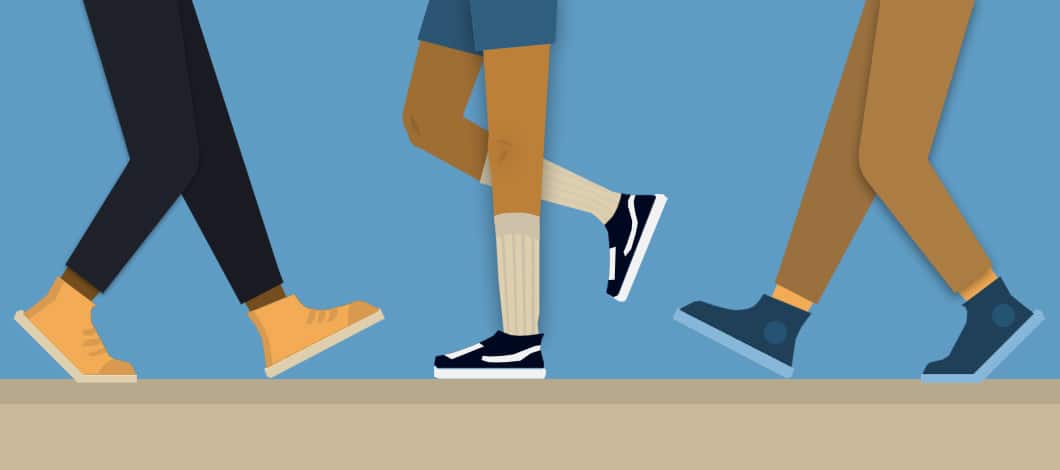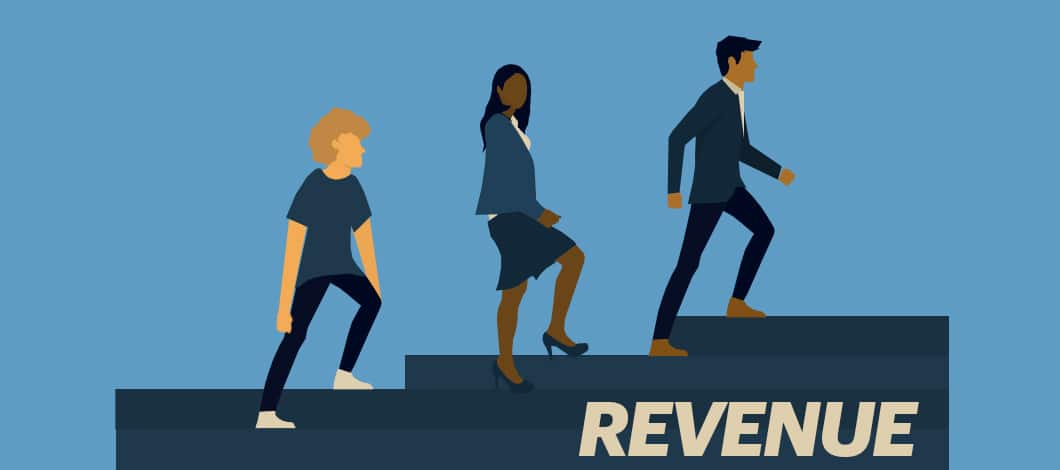As pandemic lockdown restrictions lift, retailers can expect more customer traffic. This represents a golden opportunity to increase your revenue if you know how to drive foot traffic to your store and convert it into sales.
We’ll cover what foot traffic is, how you can measure and collect it, how COVID-19 has affected traffic levels, what you can do to increase traffic as customers return to stores and how you can encourage them to make more purchases when they shop.
Here’s what you can do to get your store ready.
What Is Customer Foot Traffic?
In the retail business, foot traffic is a key performance indicator that refers to the number of shoppers who walk into a brick-and-mortar location over a given time frame. Foot traffic can be tracked for a single location such as a store or for a group of locations such as a mall or a chain of stores.
Measuring footfall traffic is important because it directly relates to revenue. A certain percentage of shoppers who enter your store will make a purchase on that visit. The more shoppers who walk into your store, the more sales you will make.
How Do You Measure Foot Traffic?
You can use a number of approaches to measure retail store foot traffic. The most fundamental way to track traffic is to count how many shoppers enter a store over a given time frame. For example, you can track how many shoppers enter the store per day.
This type of tracking can be segregated to focus on specific time frames, such as:
- During peak business hours
- Different days of the week
- During the holiday shopping season
Organizing your data this way can provide you with valuable insights into your foot traffic during the times which have the biggest impact on your sales.
Other Ways to Measure Foot Traffic
While the number of shoppers in the store at a given time is the most basic way to track foot traffic, you can gain important insights by tracking related numbers which impact your sales revenue, marketing efficiency and profits.
For example, you can track foot traffic in terms of:
- Foot traffic for specific shopping aisles or displays
- Foot traffic outside the store in areas such as mall avenues and parking lots
- Average time shoppers remain in the store or in specific areas
- Average revenue per shopper per hour
- Types of products purchased
- How many products customers bought which were on sale
Tracking this type of additional data can deepen your insight into how your foot traffic numbers correlate with where shoppers are going in your store, how much time they’re spending and what they’re buying.

How Can You Collect Foot Traffic Data?
There are a number of methods you can use to collect the data you need to analyze foot traffic. In smaller stores, your staff can track data manually.
For greater efficiency, you can use technological methods such as:
- Tracking pings from Wi-Fi and Bluetooth-enabled smartphones seeking to connect to routers
- Using in-store sensors which detect customers entering the store
- Utilizing cameras
Technology tools that track foot traffic can be linked to footfall software such as to provide insights into your data. Popular tools include Plot Projects, Purple and Adobe Experience Platform.
How Have Pandemic Lockdown Policies Altered Foot Traffic?
Lockdown store restrictions and closings sharply reduced foot traffic in 2020, according to data supplied to retail news website Retail Dive by foot traffic analytics provider Placer.ai. Traffic retail store businesses were experiencing had risen slightly in January and February, but dropped by 26% year-over-year in March, 45% in April and 30% in May, reflecting the height of the pandemic lockdowns. After that traffic began to rise slowly, to reach a point 16% below the previous year by December.
Trends so far this year point toward continued recovery, according to Placer.ai. For instance, Walmart’s foot traffic had pulled to within 0.4% year-over-year of last year’s levels by March, and by April was showing 21.7% gains. Target experienced year-over-year gains of 21.7% in March and 49.5% in April. The department store and wholesale club sectors show similar trends, pointing toward rising foot traffic for stores this year.
How Can You Prepare Your Store to Increase Customer Traffic?
As shoppers return to brick-and-mortar businesses, what can you do about getting customers into your store?
You can use many tactics to promote foot traffic, which can be grouped into several major areas:
- Digital marketing
- Geomarketing
- Sales offers
Here are some ways each of these methods can be used to encourage foot traffic in your store.
1. Use Digital Marketing to Invite Customers Back
Digital marketing provides a wide array of tools you can use to invite customers back into your store. Leverage digital marketing to encourage foot traffic by taking proactive steps:
- Check your website and social media profiles to make sure they reflect that you’re open for in-store shopping and they list your current hours
- Use Google’s local inventory ads service to let online customers know what you have available in your current inventory
- Consider offering customers the option of buying online and picking up purchases in-store
- Reach out to your social media following and email marketing list to let them know you’re open for business
- Send text messages to past customers who have opted in to receive texts
For best results, track the performance of your digital marketing efforts so you can see what’s working and what isn’t. Test different tactics to see which methods generate the most foot traffic for your store.
2. Attract Local Customers With Geomarketing
You can increase the effectiveness of digital marketing methods for generating foot traffic by combining them with geomarketing, which leverages data about customers’ locations to customize marketing campaigns.
There are several effective ways to use geomarketing to promote foot traffic from local customers:
- Use location-based data from your own data and third-party data to identify how far customers travel to visit your store so you can extend your local marketing reach accordingly
- Create web pages and content which use geographic keywords to attract local customers
- Use mobile marketing to send targeted messages to shoppers within a set distance of your store
- A digital marketing agency experienced with geomarketing can help you with implementing these methods.
3. Offer Special Sales to Returning Customers
- To make your marketing outreach more appealing to local shoppers, you can extend special sales offers to customers who shop in your store. Methods you can use include:
- Offering exclusive in-store discounts and bonuses
- Using Facebook Offer ads to promote coupons that can only be redeemed in your store
- Extending discounts to customers who buy online and come into your store to pick up their purchase
- Offering discounts and bonuses to customers who bring a friend to shop in your store
- Making services such as maintenance free for customers who come into your store
Look for ways to give customers an incentive to come into your store.

How Can You Convert Foot Traffic Into Sales Revenue?
Once customers are in your store, you can take actions to increase their likelihood of buying and the amount they spend.
Optimize your sales conversion rate and average transaction value by using methods such as:
- Placing on-sale items in strategic locations on your floor
- Training floor associates how to guide customers through buying decisions and how to suggest cross-sell and upsell offers
- Offering price matching to customers who go online to compare your prices with competitors
- Extending cross-sell and upsell offers to customers at the time of checkout
- Giving customers who have just made a purchase coupons they can redeem during future in-store visits
Use these methods to make the most of the foot traffic you generate.
Increase Your Customer Traffic to Multiply Your Revenue
Foot traffic refers to the number of customers who enter a brick-and-mortar location over a given time frame.
You can segregate foot traffic data to focus on specific times of day, days of the week or seasons of the year. You can correlate foot traffic numbers with related metrics such as where customers shop in your store, how much time they spend and how much they spend per visit. This type of data can be collected manually or through technology such as smartphones, sensors and cameras.
As lockdown restrictions have lifted, foot traffic has begun to increase. You can prepare for this change and proactively increase your foot traffic by taking steps such as promoting your store through digital marketing, using geomarketing and extending special sales offers to in-store shoppers. Once shoppers are in your store, increase your sales conversions with tactics such as strategic product placement, floor associate sales training, competitor price matching and point-of-sale offers.
Combine increased foot traffic with more efficient in-store sale strategies to make the most of post-lockdown shopping surges.










